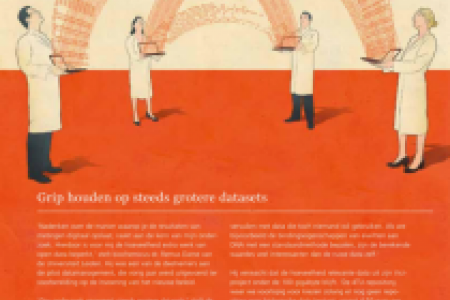Twitter and best practices
This month's spotlight is on Twitter, one of the main metrics included in altmetrics. But Twitter is more than just a source for altmetrics, it can also be a valuable information source. What are the best practices for Twitter?
This month I'll be focusing on Twitter, one of today's major social media platforms. With over 240 million monthly active users it's a large pool of potential connections with like-minded people or people interested in your research. For a more extended explanation of Twitter, see the Twitter entry in the In Depth section. There are a large number of academics on Twitter, though the number and the extent to which it is used for scholarly communication differs across the various disciplines. (Holmburg and Thelwall, 2014) However, there is evidence that tweets do correlate to later citations (Thelwall et al., 2013), which makes Twitter and tweets an interesting pool of data for the purposes of altmetrics and measuring the attention your research is getting shortly after publication.
But with such a huge number of possible contacts how can you stand out and make yourself be heard? You can find dozens of articles on Twitter Best Practices on Google, ranging from how-to's, to tips, to guidelines, and all of them have their own approach. There are common elements, however, and I've listed some of the most important ones below.
Best Practices
Be authentic: While it's important to be aware of the image you're projecting into the world and to consider what you want to achieve with your activity on Twitter, it isn't advisable to try and be someone online that you're not. Be yourself, be genuine and inject some personality into your time line. Jessica Olin, a library blogger, calls this the Popeye Principle; being yourself on Twitter will make you human to your followers, more than a name on a screen or at the top of a research paper and will make them more likely to reach out to you to connect, which might result in valuable professional connections.
Be engaging: As Ned Potter says Twitter is a conversation. But a conversation is more than just broadcasting your work and opinions into the void or just silently watching the tweets go by in your timeline. Of course, you can use Twitter that way, especially if you use it as an information gathering tool, but to get the most out of Twitter you'll need to engage. If someone mentions you, reply to them. If someone you follow shares an article that is of particular use to you thank them. If some asks a question on Twitter you know the answer to, help them out. That is the way you'll quickly make useful and worthwhile connections.
Be consistent: If you've been on Twitter for a while you've probably encountered accounts that started out enthusiastically tweeting several times a day and then petered out into silence. Or the account where the person will have flurries of huge numbers of tweets in a short time span and then nothing for ages. Try to be more even in your approach. If you know you're going to be unable to tweet for a while, schedule some tweets ahead of time using Buffer or the scheduling function in Tweetdeck or Hootsuite. Similarly, if you're going to live-tweeting a seminar or conference session, let your followers know beforehand, including the conference hashtag, so they can mute you for a few hours until the session is over. Twitter itself suggests a ratio of three to five posts a day to keep your engagement consistent.
Be timely: If you reply to someone's tweet do so in a timely fashion, not days later. Similarly, if you want to promote a blog post or new article do so shortly after publication. Of course, time limits vary per sort of publication. For example, a blog post has lost its novelty after a week at most, while an article can be considered newsworthy for much longer. Use your best judgement and if in doubt look at how your peers are doing it.
Be courteous: It doesn't take a lot of time to be courteous to others. So if someone mentions you or your work in a positive way, be sure to thank them. Similarly, if they are not complimentary, engage them in a courteous way and initiate a conversation on why they disagree with you. If you discover an article or blog post that you find really useful, share it with your followers, so they can read it too, but if you do so take the time to include the author's Twitter handle as well, so they know you've found their work valuable. If you're courteous and kind in your interactions, you'll find people will respond more often and more readily to your tweets.
Don't over-promote: Many people tweet to promote something, whether it's their brand, their work or even themselves. And while there is nothing wrong with that, too much of it quickly turns it into spamming and there is nothing that will make people unfollow you as quickly as spamming. A golden rule is 20% promotion and 80% engagement.
Don't lose your common sense: As I've said quite often before, social media and especially Twitter is a public place. You can never know who's reading your tweets. So always be aware you're speaking in public and think of what put out there. Be courteous and kind and don't say anything you wouldn't say in front of your mother or employer.
Don't auto-follow or auto-DM: Nothing says 'I want to get as many followers as I can and I'm not really interested in truly engaging with them' as auto-following people back and/or sending an automated DM with a link to your work when someone follows you. Don't do it. If you want to greet each new follower personally that's wonderful, but do so in a personal manner and not with a standardised message.
You can also find a lovely visual representation of best Twitter practices on the Passion Digital blog.
References
Holmberg, K. & Thelwall, M. (2014). Disciplinary differences in Twitter scholarly communication. Scientometrics. doi: 10.1007/s11192-014-1229-3
Thelwall M, Haustein S, Larivière V, Sugimoto CR (2013) Do Altmetrics Work? Twitter and Ten Other Social Web Services. PLoS ONE 8(5): e64841.
doi:10.1371/journal.pone.0064841





